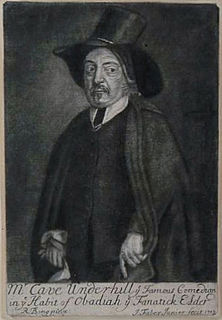
William Congreve was an English playwright and poet of the Restoration period. He is known for his clever, satirical dialogue and influence on the comedy of manners style of that period. He was also a minor political figure in the British Whig Party.
This article presents lists of the literary events and publications in 1664.
Nahum Tate was an Irish poet, hymnist and lyricist, who became Poet Laureate in 1692. Tate is best known for The History of King Lear, his 1681 adaptation of Shakespeare's King Lear.
Susanna Verbruggen, aka Susanna Mountfort, was an English actress working in London.
William Mountfort, English actor and dramatic writer, was the son of a Staffordshire gentleman.

The Theatre Royal Haymarket is a West End theatre on Haymarket in the City of Westminster which dates back to 1720, making it the third-oldest London playhouse still in use. Samuel Foote acquired the lease in 1747, and in 1766 he gained a royal patent to play legitimate drama in the summer months. The original building was a little further north in the same street. It has been at its current location since 1821, when it was redesigned by John Nash. It is a Grade I listed building, with a seating capacity of 888. The freehold of the theatre is owned by the Crown Estate.

Thomas Killigrew was an English dramatist and theatre manager. He was a witty, dissolute figure at the court of King Charles II of England.
Mary Kent was an English actress, whose career lasted from 1692 to 1718, and the wife of Drury Lane actor Thomas Kent. Her dates of birth and death are not known. Mary Kent appeared in many playbills from 1692 onwards in London, playing minor parts in the United Company until the company's tumultuous breakup in 1695. She and her husband remained with the depleted parent troupe when the senior actors walked out to set up their own cooperative company, and during the consequent brief actor shortage at Drury Lane, she played more important parts, notably Flareit in Colley Cibber's Love's Last Shift and young Tom Fashion in John Vanbrugh's The Relapse in 1697. This role came at a time when it was common for boys to be portrayed by actresses and her casting was described as perhaps "an attempt to defuse the homosexual suggestions in his relationship with Coupler."
Henry The Second, King Of England; With The Death Of Rosamond is a 1692 historical play often attributed to William Mountfort but possibly written by John Bancroft. It was first staged at the Theatre Royal, Drury Lane by the United Company. The prologue and epilogue were written by John Dryden. Some incidental music was composed by Henry Purcell.

Cave Underhill (1634–1710?) was an English actor in comedy roles.

Amphitryon is an English language comedy by John Dryden which is based on Molière's 1668 play of the same name which was in turn based on the story of the Greek mythological character Amphitryon as told by Plautus in his play from ca. 190-185 B.C. Dryden's play, which focuses on themes of sexual morality and power, premiered in London in 1690. Notable innovations in Dryden's adaptation compared to previous plays on Amphitryon included music by Henry Purcell and the character of Phaedra, who flirts with Sosia but is eventually won over by Mercury's promises of wealth.
Samuel Sandford was an English character actor, known for his roles as villains.
John Bowman (1651–1739) was a British stage actor. He began his career in the Duke's Company at the Dorset Garden Theatre. In 1692 he married Elizabeth Watson, who acted under the name Elizabeth Bowman. He later switched to act at the Drury Lane Theatre. He is also referred to as John Boman.
William Bowen (1666–1718) was a British stage actor. He was part of the United Company from 1689. For a time he became known for his comic roles. Having been involved in several incidents during his lifetime, he was fatally wounded in a duel with fellow actor James Quin in 1718.
Joseph Williams was an English stage actor of the seventeenth and early eighteenth century.
George Bright was an English stage actor of the seventeenth and early eighteenth century. He specialised in playing "comic dullards, fops and bouncy servants". After beginning his career in Dublin he joined the Duke's Company at the Dorset Garden Theatre in 1679 and then became part of the merged United Company in 1682.
Sir Anthony Love; Or, The Rambling Lady is a 1690 comedy play by the Irish writer Thomas Southerne. It was originally staged by the United Company at the Theatre Royal, Drury Lane with a cast that included Susanna Mountfort in a breeches role as Sir Anthony Love, William Mountfort as Valentine, Joseph Williams as Ilford, William Bowen as Sir Gentle Golding, Anthony Leigh as An Abbe, John Hodgson as Count Canaile, Samuel Sandford as Count Verole, George Bright as Waitwell, Colley Cibber as Servant to Sir Gentle, Charlotte Butler as Floriante, Anne Bracegirdle as Charlote and Frances Maria Knight as Volante. The play's incidental music was composed by Henry Purcell.
John Hodgson was an English stage actor of the late seventeenth century. He joined the United Company in 1688 and his first recorded appearance was in The Treacherous Brothers at Drury Lane in 1690. In 1695 he was one of several actors who broke away to join Thomas Betterton's new company at Lincoln's Inn Fields. His name is sometimes written as Hudson. He was married to the singer Mary Hodgson.
The Maid's Last Prayer: Or, Any Rather Than Fail is a 1693 comedy play by the Irish writer Thomas Southerne. It was first staged at the Theatre Royal, Drury Lane by the United Company.

The Fortune Hunters; Or, Two Fools Well Met is 1689 comedy play by James Carlile. It was originally staged by the United Company at the Theatre Royal, Drury Lane in London.





